Black Swan Bird Cygnus atratus
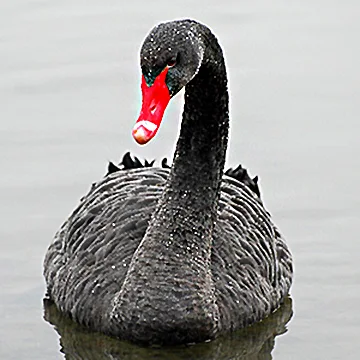
Contents
Black Swan Description
The black swan is a large waterbird with sleek black feathers, vivid red eyes, and a red bill marked by a white stripe. It measures 110–142 cm (4.3–4.6 ft) long, with a wingspan of 1.6–2 m (5–6.5 ft), and weighs 4–9 kg (9–20 lb). Males and females are similar in appearance, though males are slightly larger with a longer straighter bill. They have white flight feathers, but are hidden until they take to the air. Black swans make a high-pitched musical bugle-like sound that includes honks. It also croons and makes a whistling sound while nesting and breeding. It may hiss aggressively if threatened.
Black swans fly slowly, with its neck outstretched, reaching speed of up to 80kph. They often fly in wedge formations. Graceful in water and air, they are awkward on land and rarely walk unless food is scarce.
The scientific name for the black swan is Cygnus atratus. Other names for a group of black swans include ballet, bevy, drift, herd, or regatta. A black swan has a lifespan of up to 40 years.
Difference Between Black Swan and White Swan
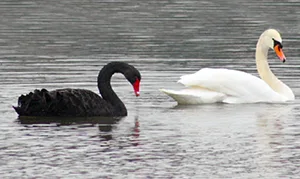
Photo: Black and white swans
The key difference between black swans and white swans are their colour and size. White swans, found in the western hemisphere, have white feathers and an orange beak with a black tip and are slightly larger than black swans. Black swans, found in the Southern hemisphere, particularly in Australia, have black feathers, a red beak with a white stripe, and are slightly smaller than white swans.
Black swans and white swans share many similarities, including their basic anatomical shape and habitat preferences. Although interbreeding between the two is rare, it can produce viable offspring.
Black Swan Habitat & Distribution
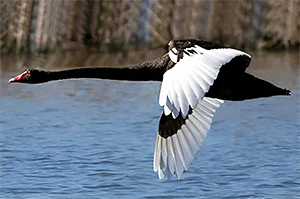
Photo: Black Swan in flight
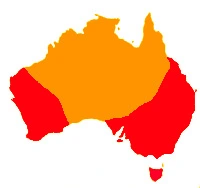
Photo: Black Swan habitat map
Black swans are native to Australia and live in the country's western and eastern regions. They prefer to live in temperate to tropical bodies of water such as lakes, rivers, estuaries, and swamps. These birds require large, unobstructed waterways of at least 40 meters to use as a runway for taking off and landing due to their size. Black swans are well adapted to an aquatic lifestyle. They are often seen gracefully swimming with their necks arched in an S-shape. They are also skilled divers, using their webbed feet to propel themselves underwater in search of food. Although they do not migrate, black swans are nomadic and travel from place to place in search of suitable water bodies with enough food. They often travel at night and form a line or V-shaped formation when flying in a group.
Black Swan Diet
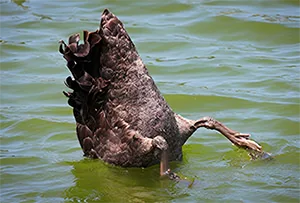
Photo: Black Swan diving for food
Black swans eat aquatic vegetation such as algae, water weeds, and submerged plants. They also consume insects, molluscs, and small crustaceans in the water. They are also filter feeders, sometimes running their bills along the water's surface to capture floating plants and small insects. Black swans may also graze on grasses and other terrestrial plants near the water's edge.
Black Swan Reproduction & Life Cycle
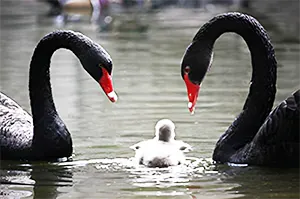
Photo: Black Swan parents with chick
Black swans reach sexual maturity when they are about two years old. Most start breeding in their third year. Breeding can occur all year but usually takes place between February and May in tropical climates and between May and September in cooler temperate climates.
While younger black swans may be promiscuous by having many partners, older black swans are monogamous, with a male and female pairing for life.
Breeding pairs work together to construct large nests above the water on small islands, in tall bushes or on mounds of vegetation made from reeds, grass, and other vegetation. The nest is about one and a half meters in diameter and half a meter high. Both partners share in maintaining the nest.
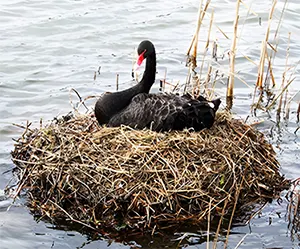
Photo: Black Swan nesting
Black swans lay a clutch of 4-8 greenish-white eggs, with one egg laid every two days. During this time, both parents take turns sitting on the eggs to protect them but do not warm them until the entire clutch has been laid. After the final egg is laid, both parents share in the incubation process, which lasts between 35 to 45 days.
The eggs hatch independently, with the cygnets (baby swans) emerging from their egg over several days. They have soft grey-brown feathers for the first three to four weeks before their black feathers begin to appear. Both parents play an active role in caring for the cygnets, teaching them how to swim and find food while protecting them from danger. The cygnets stay with their parents for about nine months, often hitching a ride on their backs when travelling in deep water. They reach breeding age in about 18 months.
Black Swan Same-Sex Parenting
It has been estimated that up to 33% of black swans are gay, and nearly 25% of all black swan couples are same-sex couples. These couples are almost always two males getting together. These males sometimes steal a nest from a heterosexual couple and raise the young as their own. Or one male copulates with a female, and once she has laid her eggs, the homosexual couple chases the female away and raises the chicks themselves.
Scientists believe this behaviour has a biological advantage as there is a higher survival rate amongst chicks raised by male-male couples than by male-female pairs. This may be because there is an additional male to protect the chicks. Or by choosing to be parents, they are more caring than natural heterosexual pairs.
Note: Homosexual behaviour amongst animals has been observed in over 1500 species. Besides black swans, these include giraffes, vultures, bears, and dolphins.
Black Swan Predators & Threats
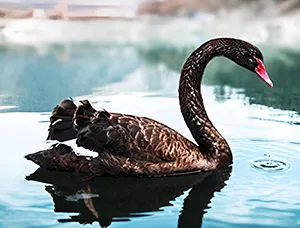
Photo: Black Swan
While adult black swans are not typically preyed upon by native predators, their young signets are vulnerable to attacks from large birds of prey and introduced animals like dogs, cats, and foxes. However, the biggest threats to the black swan population are habitat loss, water pollution, and human interference. Unfortunately, well-meaning individuals who feed these birds can actually do more harm than good. When black swans become dependent on humans for food, they lose their natural foraging instincts and become less wary of both humans and predators, making them more vulnerable to attacks.
Is the Black Swan Endangered?
The black swan, with a global population of approximately 500,000, is not currently considered endangered or threatened. However, in in parts of Victoria and Tasmania, their numbers have grown to the point where they have caused significant crop damage. As a result, the government has implemented a restricted hunting season to control their population. Despite this, it is still illegal to hunt, capture, or kill black swans.
European Discovery of the Black Swan
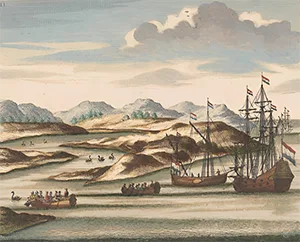
Photo: Painting of Europeans sailing into Swan River
European explorers were astounded when they first discovered black swans in Australia. Black swans were thought not to exist, until they were discovered. The first sighting of black swans was made by Antonie Caen, a sailor on the Dutch sailing ship the Banda, in 1636 near Bernier Island off the south-western coast of Australia. It wasn't until 1697 that the Dutch explorer Willem de Vlamingh captured two of these birds in what is now known as the Swan River in Perth, Australia. Sadly, the birds did not survive the voyage back to Holland.
Black Swan Event
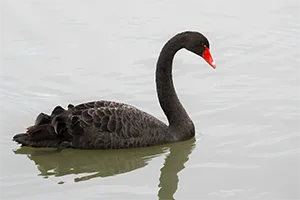
Photo: "Black Swan Event" is named after this bird
The term "black swan event" was coined in 2007 by Nassim Nicholas Taleb, a finance professor and author, to describe an unexpected and rare event that has a significant impact. These events are often impossible to predict and can have catastrophic consequences. The term comes from the fact that black swans were once thought to be non-existent, until they were discovered in Australia. The 2008 financial crisis is a prime example of a black swan event, as it caught many experts off guard despite warning signs being present.